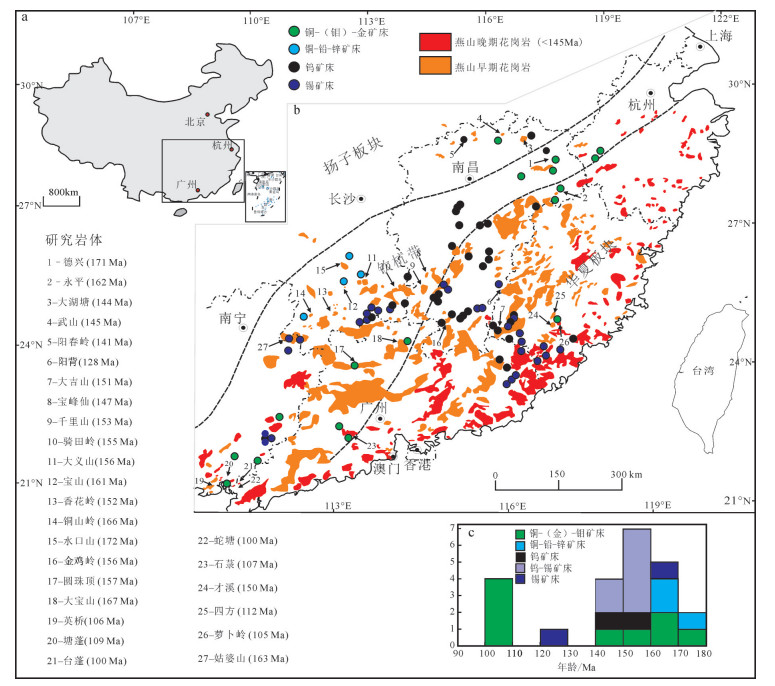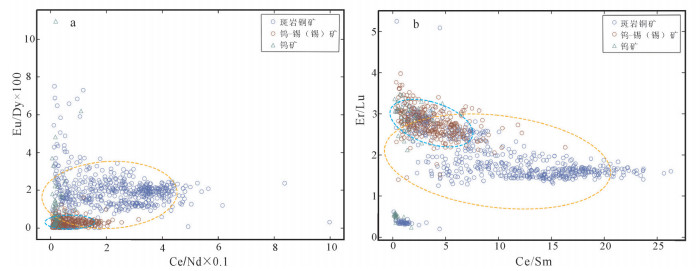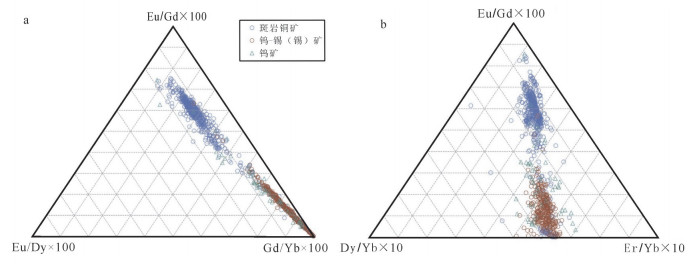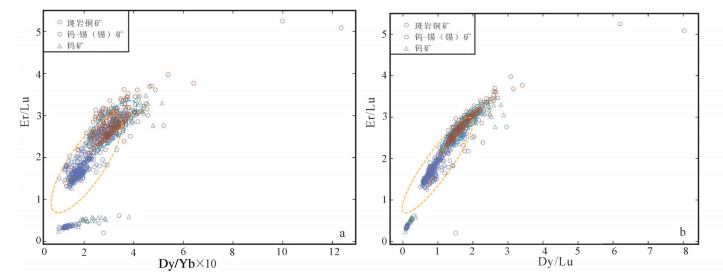The discrimination between ore-forming and barren granites based on zircon REE compositions: Insights from big data mining
-
摘要:
华南钦杭结合带燕山期岩浆活动异常活跃,且具有较明显的成矿专属性。近年来微区测试技术日益成熟,积累了大量锆石微量数据。通过全体数据挖掘的思维方法,对前人发表的数据进行了进一步数据挖掘,利用锆石稀土元素对岩体成矿潜力进行判别,探讨有效的找矿地球化学标志。利用Python语言编程,对采用的13种稀土元素及元素比值进行穷举式组合,获得了4095个二元图解及121485个三元图解,并设计筛选算法,自动筛选出能有效区分锆石母岩成矿类型的图解。结果表明,锆石稀土元素含量及比值图解对不同成矿类型岩体的区分程度各异:与Ce、Eu有关的地球化学指标可以较清晰地对斑岩铜矿和钨锡(锡)矿床进行判别,这可能与岩体的氧逸度和含水量有关。此外,还挖掘出一些新的元素组合图解,如Dy/Lu-Er/Lu、Gd/Dy-Er/Yb等,可以有效区分岩体成矿类型,其隐含的地球化学机制尚待进一步解释。地球化学数据挖掘结果可以作为找矿标志使用,为华南燕山期岩浆-热液矿床研究及找矿勘查提供了科学依据,也是大数据技术在矿床学方面应用研究的积极探索。
Abstract:Yanshanian magmatism is well developed and has obvious metallogenic specificity in Qinzhou-Hangzhou Bays of South China. With the development of in-situ zircon analysis technology, a huge number of zircon composition data has been accumulated in recent years. On the basis of collecting data published by previous researchers, the authors determined the ore-forming potential of rock masses by using zircon REE compositions through big data thinking method, and explored effective geochemical indicators for ore prospecting. Python language was used to program arbitrary combination of elements. A total of 4095 binary diagrams and 121485 ternary diagrams were obtained, and diagrams that could effectively distinguish zircon parent rock metallogenic types were automatically screened out. The results show that different types of ore-forming rocks have different degrees of differentiation. Geochemical indices related to Ce and Eu can be well distinguished, which may result from the oxygen fugacity and water content of magma. Additionally, it is observed that some new element association diagrams (i.e., Dy/Lu-Er/Lu, Gd/Dy-Er/Yb) can distinguish ore-forming types of rock bodies effectively, but the underlying geochemical mechanism has not been fully understood. In brief, the results of geochemical data mining in this paper can be used as the prospecting indicators, which can provide scientific basis for the study and prospecting of Yanshanian hydrothermal deposits in South China, and can also be used to actively explore the application of big data technology in mineralogy.
-
Key words:
- zircon /
- trace elements /
- big data /
- mineralization property /
- geochemical diagram
-

-
[1] Grimes C B, Wooden J L, Cheadle M J, et al."Fingerprinting" tectono-magmatic provenance using trace elements in igneous zircon[J]. Contrib. Mineral. Petrol., 2015, 170(46):1-26. http://www.wanfangdata.com.cn/details/detail.do?_type=perio&id=8a25a5ed3f86737db4c5947bc56e2f0f
[2] 赵振华, 严爽.矿物——找矿与成矿[J].岩石学报, 2019, 35(1):31-68. http://d.old.wanfangdata.com.cn/Periodical/ytgcj201505012
[3] Blevin P L. Redox and compositional parameters for interpreting the granitoid metallogeny of eastern Australia:implications for gold-rich ore systems[J]. Resource Geology, 2004, 54:241-252. http://cn.bing.com/academic/profile?id=14f40b483c12cb0e4f82f6c4aca93b24&encoded=0&v=paper_preview&mkt=zh-cn
[4] Li X, Chi G, Zhou Y, et al. Oxygen fugacity of Yanshanian granites in South China and implications for metallogeny[J]. Ore Geology Reviews, 2017, 88:690-701. http://www.wanfangdata.com.cn/details/detail.do?_type=perio&id=28dc77d4ffaa488e323eea0fbf67ce44
[5] Shen P, Hattori K, Pan H, et al. Oxidation condition and metal fertility of granitic magmas:zircon trace-element data from porphyry Cu deposits in the Central Asian Orogenic Belt[J]. Economic Geology, 2015, 110:1861-1878. http://cn.bing.com/academic/profile?id=f6fe3a0644a46c40571f18991dd6433b&encoded=0&v=paper_preview&mkt=zh-cn
[6] Ballard J R, Palin J M, Campbell I H. Relative oxidation states of magmas inferred from Ce(Ⅳ)/Ce(Ⅲ) in zircon:application to porphyry copper deposits of northern Chile[J]. Contrib. Mineral. Petrol., 2002, 144(3):347-364.
[7] Dilles J H, Kent A J R, Wooden J L, et al. Zircon compositional evidence for sulfur-degassing from ore-forming arc magmas[J]. Economic Geology, 2015, 110:241-251. http://www.wanfangdata.com.cn/details/detail.do?_type=perio&id=01d5461b6497e27f7f847d3a07569570
[8] 周永章, 王俊, 左仁广, 等.地质领域机器学习、深度学习及Python语言[J].岩石学报, 2018, 34(11):3173-3178. http://www.ysxb.ac.cn/ysxb/ch/reader/view_abstract.aspx?file_no=20181102&flag=1
[9] 周永章, 陈烁, 张旗, 等.大数据与数学地球科学研究进展——大数据与数学地球科学专题代序[J].岩石学报, 2018, 34(1):256-263. http://www.wanfangdata.com.cn/details/detail.do?_type=perio&id=ysxb98201802001
[10] 王金荣, 潘振杰, 张旗, 等.大陆板内玄武岩数据挖掘——成分多样性及在判别图中的表现[J].岩石学报, 2016, 32(7):1919-1933. http://d.old.wanfangdata.com.cn/Periodical/ysxb98201607001
[11] 杨婧, 王金荣, 张旗, 等.全球岛弧玄武岩数据挖掘——在玄武岩判别图上的表现及初步解释[J].地质通报, 2016, 35(12):1937-1949. http://dzhtb.cgs.cn/gbc/ch/reader/view_abstract.aspx?file_no=20161201&flag=1
[12] Liu X L, Zhang Q, Li W C, et al. Applicability of large-ion lithophile and high field strength element basalt discrimination diagrams[J]. International Journal of Digital Earth, 2017, 11(7):752-760. http://www.wanfangdata.com.cn/details/detail.do?_type=perio&id=10.1080/17538947.2017.1365959
[13] Lu Y J, Loucks R R, Fiorentini M. Zircon Compositions as a Pathfinder for Porphyry Cu ±Mo ±Au Deposits[J]. Economic Geology, 2016, 19:329-347.
[14] 李晓峰, 易先奎, 朱和平.德兴金山金矿床成矿流体来源:小尺度构造和同位素地球化学证据[J].矿床地质, 2009, 28(1):42-52. http://d.old.wanfangdata.com.cn/Periodical/kcdz200901004
[15] Li Z. Geochronology of Neoproterozoic syn-rift magmatism in the Yangtze Craton, South China and correlations with other continents:evidence for a mantle superplume that broke up Rodinia[J]. Precambrian Research, 2003, 122(1/4):85-109. http://cn.bing.com/academic/profile?id=f37b2e324eb8eddd96446f3e3d501681&encoded=0&v=paper_preview&mkt=zh-cn
[16] Zhou X, Sun T, Shen W, et al. Petrogenesis of Mesozoic granitoids and volcanic rocks in South China:A response to tectonic evolution[J]. Episode, 2006, 29:26-33. http://cn.bing.com/academic/profile?id=8265c4b55de950ade7768c2a1625f1f4&encoded=0&v=paper_preview&mkt=zh-cn
[17] Qiu J T, Yu X Q, Santosh M, et al. The Late Mesozoic tectonic evolution and magmatic history of west Zhejiang, SE China:implications for regional metallogeny[J]. International Journal of Earth Sciences, 2014, 103(3):713-735. http://cn.bing.com/academic/profile?id=6af7f92643c750951622bc56c1959602&encoded=0&v=paper_preview&mkt=zh-cn
[18] 华仁民, 陈培荣, 张文兰, 等.南岭与中生代花岗岩类有关的成矿作用及其大地构造背景[J].高校地质学报, 2005, 11(3):291-304. http://d.old.wanfangdata.com.cn/Periodical/gxdzxb200503002
[19] 毛景文, 张建东, 郭春丽.斑岩铜矿-浅成低温热液银铅锌-远接触带热液金矿矿床模型:一个新的矿床模型——以德兴地区为例[J].地球科学与环境学报, 2010, 32(1):1-14. http://d.old.wanfangdata.com.cn/Periodical/xagcxyxb201001001
[20] 张文兰, 华仁民, 王汝成, 等.赣南大吉山花岗岩成岩与钨矿成矿年龄的研究[J].地质学报, 2006, 80:956-962. http://d.old.wanfangdata.com.cn/Periodical/dizhixb200607003
[21] Jie S X, Lei W X, Tao S, et al. Trace elements, U-Pb ages and Hf isotopes of zircons from Mesozoic granites in the western Nanling Range, South China:Implications for petrogenesis and W-Sn mineralization[J]. Lithos, 2011, 127:468-482. http://cn.bing.com/academic/profile?id=1bbdda5cdb722807cff3877a1ec08cda&encoded=0&v=paper_preview&mkt=zh-cn
[22] Feng Z H, Wang C Z, Zhang M H, et al. Unusually dumbbellshaped Guposhan-Huashan twin granite plutons in Nanling Range of south China:Discussion on their incremental emplacement and growth mechanism[J]. ournal of Asian Earth Sciences, 2012, 48:9-23.
[23] Huang L C, Jiang S Y. Highly fractionated S-type granites from the giant Dahutang tungsten deposit in Jiangnan Orogen, Southeast China:geochronology, petrogenesis and their relationship with Wmineralization[J]. Lithos, 2014, 202:207-226.
[24] Mao J, Zhang J, Pirajno F, et al. Porphyry Cu-Au-Moepithermal Ag-Pb-Zn-distal hydrothermal Au deposits in the Dexing area, Jiangxi province, East China-A linked ore system[J]. Ore Geology Reviews, 2011, 43(1):203-216. https://www.researchgate.net/publication/251527962_Porphyry_Cu-Au-Mo-epithermal_Ag-Pb-Zn-distal_hydrothermal_Au_deposits_in_the_Dexing_area_Jiangxi_province_East_China-A_linked_ore_system
[25] 梁锦, 周永章, 李红中, 等.钦-杭结合带斑岩型铜矿的基本地质特征及成因分析[J].岩石学报, 2012, 28:3361-3372. http://d.old.wanfangdata.com.cn/Periodical/ysxb98201210022
[26] Hong J S, Liang Q L, Leon B, et al. Geodynamic setting of the Zijinshan porphyry-epithermal Cu-Au-Mo-Ag ore system, SW Fujian Province, China:Constrains from the geochronology and geochemistry of the igneous rocks[J]. Ore Geology Reviews, 2013, 53:287-305. http://cn.bing.com/academic/profile?id=748aa61ce86af106fd73ea4526f66870&encoded=0&v=paper_preview&mkt=zh-cn
[27] Lukasik S, Kowalski P A, Charytanowicz M, et al. Clustering using Flower Pollination Algorithm and Calinski-Harabasz Index[C]//Proceedings of the Evolutionary Computation, 2016.
[28] Trail D, Waston E B, Tailby N D. The oxidation state of Hadean magmas and implications for early earth's atmosphere[J]. nature, 2011, 480:79-82. http://cn.bing.com/academic/profile?id=55f78fa37ccec499191a9f40eae3056a&encoded=0&v=paper_preview&mkt=zh-cn
[29] Liang H Y, Sun W, Su W, et al. Porphyry copper-gold mineralization at Yulong, China, promoted by decreasing redox potential during magnetite alteration[J]. Economic Geology, 2009, 104:587-596.
[30] Qiu J T, Yu X Q, M S, et al. Geochronology and magmatic oxygen fugacity of the Tongcun molybdenum deposit, northwest Zhejiang, SE China[J]. Miner Deposita, 2013, 48:545-556. http://www.wanfangdata.com.cn/details/detail.do?_type=perio&id=66e856d30056778c64815686d10931ab
[31] Richards J P. The oxidation state, and sulfur and Cu contents of arc magmas:implications for metallogeny[J]. Lithos, 2015, 233:27-45. http://cn.bing.com/academic/profile?id=d6ace9938c4126c1a011f15825a9f8e3&encoded=0&v=paper_preview&mkt=zh-cn
[32] Richards J P. Postsubduction porphyry Cu-Au and epithermal Au deposits:Products of remelting of subduction-modified lithosphere[J]. Geology, 2009, 37:247-250. http://cn.bing.com/academic/profile?id=9ef8e00f52e3a033669633c7a970991c&encoded=0&v=paper_preview&mkt=zh-cn
[33] Sun W, Huang R F, Li H, et al. Porphyry deposits and oxidized magmas[J]. Ore Geology Reviews, 2015, 65:97-131. http://d.old.wanfangdata.com.cn/NSTLQK/NSTL_QKJJ0232405025/
[34] Sun W, Arculus R J, Kamenetsky V S, et al. Release of goldbearing fluids in convergent margin magmas prompted by magnetite crystallization[J]. nature, 2004, 431:975-978. http://cn.bing.com/academic/profile?id=764e89b5fb7f5c7efbe5aa6c1790b9f6&encoded=0&v=paper_preview&mkt=zh-cn
[35] Liang H Y, Campbell I H, Allen C. Zircon Ce4+/Ce3+ ratios and ages for Yulong ore-bearing porphyries in eastern Tibet[J]. Miner Deposita, 2006, 41:152-159.
[36] 辛洪波, 曲晓明.西藏冈底斯斑岩铜矿带含矿岩体的相对氧化状态:来自锆石Ce(Ⅳ)/Ce(Ⅲ)比值的约束[J].矿物学报, 2008, 28:152-160. http://d.old.wanfangdata.com.cn/Periodical/kwxb200802007
[37] Li C Y, Zhang H, Wang F Y, et al. The formation of the Dabaoshan porphyry molybdenum deposit induced by slab rollback[J]. Lithos, 2012, 150:101-110. http://www.wanfangdata.com.cn/details/detail.do?_type=perio&id=27f880c3bd8b822458f3a45b3f2b5e3c
[38] 胥磊落, 毕献武, 陈佑纬, 等.云南金平铜厂斑岩铜钼矿区岩体锆石Ce4+/Ce3+比值及其对成矿的指示意义[J].矿物学报, 2012, 32:74-82. http://www.wanfangdata.com.cn/details/detail.do?_type=perio&id=kwxb201201011
[39] 黄文婷, 李晶, 梁华英, 等.福建紫金山矿田罗卜岭铜钼矿化斑岩锆石LA-ICPMS U-Pb年龄及成矿岩浆高氧化特征研究[J].岩石学报, 2013, 29:283-293. http://www.wanfangdata.com.cn/details/detail.do?_type=perio&id=ysxb98201301022
[40] Hou Z, Zhang H, Pan X, et al. Porphyry (Cu-Mo-Au) deposits related to melting of thickened mafic lower crust:examples from the eastern Tethyan metallogenic domain[J]. Ore Geology Reviews, 2011, 39:21-45. http://d.old.wanfangdata.com.cn/NSTLQK/10.1016-j.oregeorev.2010.09.002/
-




 下载:
下载:



